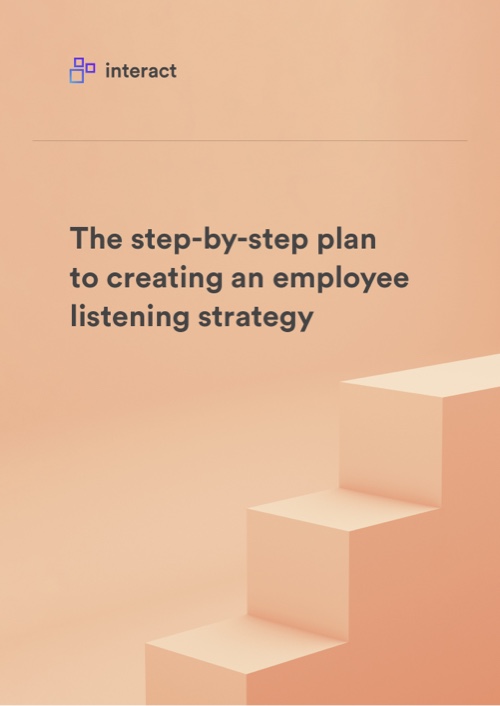In your search for workplace technology that empowers employees to contribute to the direction of everything from products, strategy, and people management, you may find yourself asking what is an idea management software? In this article we take a deep dive into what idea management software is, why it matters, how it works, and how leading organizations are already using it to innovate and thrive.
The McDonald’s Happy Meal has been a brand staple recognized across the world since its inception. It’s also an inspiring example of how transformative ideas can come from anywhere.
Today, Dick Brams is known as the “father of the Happy Meal” and credited by sources like TIME Magazine for creating the mind-bogglingly successful concept. The Happy Meal alone continues to drive an estimated $10 million in revenue every single day.
And yet… at least three different people within the organization can credibly claim to have been the originator of this iconic idea. The longstanding debate over the true source of the concept—and the apparent parallel thinking that occurred—underscores the importance of managing contributions from all members of an organization to encourage and implement innovative ideas.
Idea management software tackles this challenge head-on.
Table of contents
- Employee listening: Tuning in to great ideas
- How an idea management software maximizes potential
- Why an idea management software leads to more engaged employees
- Idea management software in the modern intranet vs. standalone solutions
- Features your idea management software needs
- Build vs. buy: Choosing the right idea management option
- Idea Management integration with Microsoft Teams
- Top tips for a successful employee ideas campaign
- Real-world examples of idea management success
- Beyond idea capture: Cultivating a culture of continuous innovation
Employee listening: Tuning in to great ideas
Companies that value and act on employee ideas are better equipped to innovate, improve, and foster employee satisfaction. Who better to prescribe creative remedies that will benefit a business than those who can best diagnose its problems from the inside?
New ways of thinking can come from each and every level within the organization, not just from management. At any given time, the next transformative idea might be taking shape in the mind of an employee, waiting to be considered and adopted to drive positive change. By embracing and implementing their ideas, companies can improve efficiency, increase retention, and bolster the bottom line.
The step-by-step plan to creating an employee listening strategy
“Workplace trust is particularly critical to innovation,” a Gartner report recently advised. “In high-trust organizations, 79% of employees bring new ideas to their managers as opposed to 17% in low-trust organizations.” When employees feel that their ideas are valued and acknowledged, it also boosts morale and motivation. They’re more likely to contribute their best ideas and are more motivated to go the extra mile to drive organizational success.
That critical trust can be cultivated by using technology to break down the traditional hierarchies that smother ideas, and provide the entire organization with a streamlined, intuitive way to contribute new viewpoints and have their voices heard.
How an idea management software maximizes potential
Even in environments where employee ideas are welcomed, at a large enough scale it can still be a struggle to manage the firehose of employee ideas without the right systems and tools in place to use them effectively.
A whopping 83% of employees do not believe they are heard ‘fairly or equally’ by the employers, and 60% feel that their opinions and views are ignored, according to research. This highlights the urgent requirement for a system that can capture and evaluate employee ideas, allowing them to feel heard, and helping organizations to tap into their greatest asset: their people.
When there’s a disconnect between creative minds and a process for implementing their ideas, it’s no wonder valuable contributions get lost or overlooked. In turn, this lack of a clear system can stifle creativity and enthusiasm. Employees who see their suggestions go nowhere are less likely to share future insights—even if they see areas for improvement that managers might miss—because they assume their ideas will just end up gathering dust on a forgotten shelf, regardless of their merit.
But imagine if the entire workforce could contribute their unique creative wisdom, all within a familiar and engaging platform that helps ensure no idea is neglected. This is exactly the kind of reality made possible by a modern employee experience platform (EXP) that centralizes the entire idea management process.
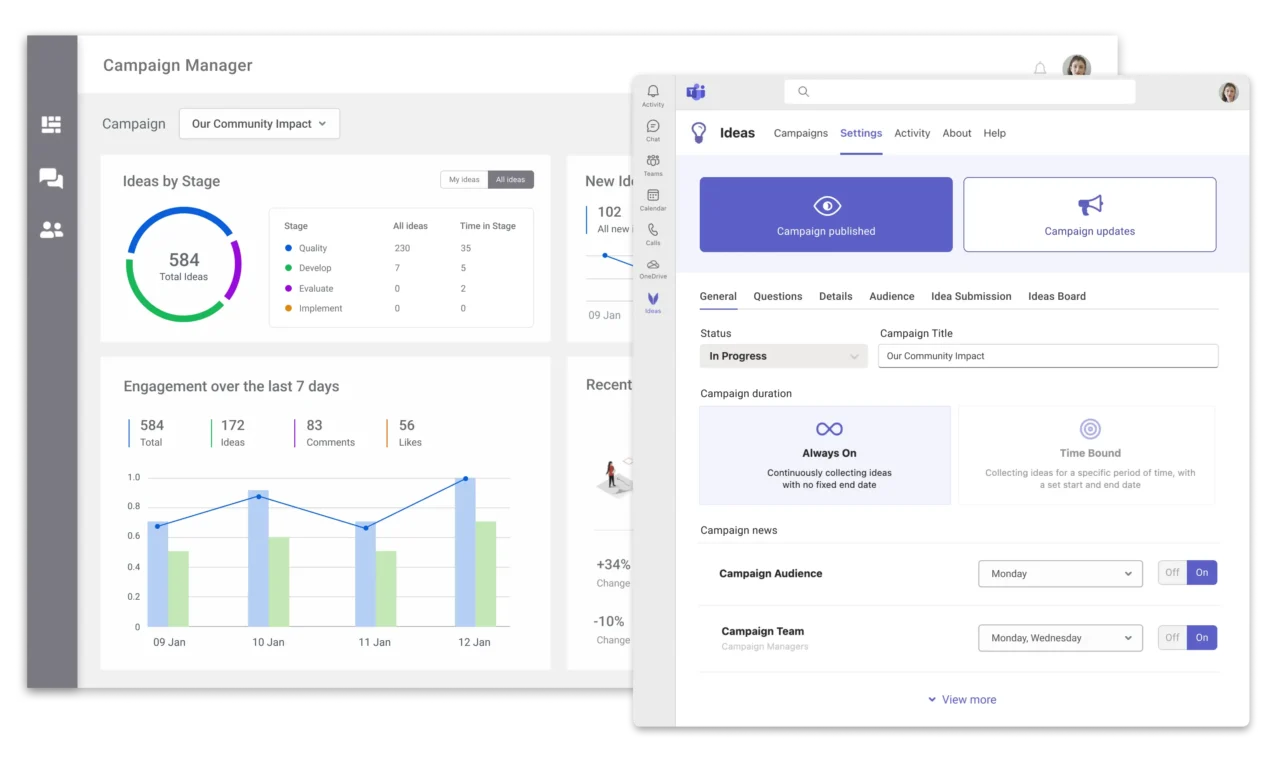
Ultimately, a well-designed idea management strategy paves the way for long-term success by harnessing the collective creativity of its workforce and fostering a culture of continuous improvement. With a strategy in place, implementing an idea management platform acts as the real catalyst, transforming a company from a passive recipient of suggestions into a dynamic hub where creativity thrives.
An idea management platform should be designed to fuel the innovation engine within large organizations by transforming the way ideas are captured and prioritized. It should act as a central hub, empowering every employee to contribute their voice and be heard.
And it should do much more than simply collect ideas. Idea management software should be able to automatically analyze the entire archive of suggestions, helping to prioritize the most impactful ones based on predetermined criteria and allowing the organization to focus its efforts on those with the greatest potential for positive change. By eliminating duplicate submissions and automatically assigning next-step tasks, the software should help remove roadblocks and accelerate the innovation cycle. It should also allow employees across continents to share their perspectives in a convenient, asynchronous manner that eliminates time zone limitations and encourages participation from a wider audience.
All of this can deliver faster time-to-market for new ideas, positioning organizations to quickly gain a competitive edge.
Why an idea management software leads to more engaged employees
The benefits of idea management software extend far beyond the ideas themselves. It facilitates a culture of open communication and psychological safety, where employees feel empowered to contribute their individual perspectives and solutions.
A truly collaborative environment can create a powerful sense of ownership and purpose among employees, who become more engaged and invested in the success of the organization. Gallup analysis finds that engagement has nearly four times as much influence on employee stress as work location. In other words, what people experience in their everyday work — their feelings of involvement and enthusiasm — matters more in reducing stress than where they are sitting.
Gallup also found that only about 30% of employees believe their opinions matter at work. There are also suggestions that younger generations entering the workforce are less likely to contribute ideas than elder generations. It’s a concerning trend that could lead to a potential loss of valuable innovation for organizations that don’t encourage, facilitate, and acknowledge participation from all age groups.
In today’s digital landscape, employee app fatigue is also a real concern. Ideally, organizations should be able to integrate their listening strategy seamlessly into their employees’ existing digital workspace. Utilizing existing platforms like the intranet or collaboration tools like Microsoft Teams can offer familiar and convenient channels for feedback and updates.
The step-by-step plan to creating an employee listening strategy
When executed through a centralized platform that employees are comfortable with, idea management transforms what is traditionally a passive, bureaucratic, and often intimidating process into a dynamic collaborative network that is accessible to everyone.
The benefits can be felt throughout the entire organization. Imagine empowering frontline workers to directly submit ideas from the field, allowing them to share valuable insights gleaned from their unique vantage point. McKinsey’s State of Organizations report highlights the real-world impact of frontline employee engagement, telling the story of one trucking company that was plagued by driver turnover due to inconvenient hours. When it began allowing drivers to propose solutions, they proposed the idea of giving customers the option to pay more for overnight deliveries. The idea went into effect and driver turnover decreased significantly.
Idea management software in the modern intranet vs. standalone solutions
By harnessing an EXP, idea management becomes more than just a one-off initiative – it becomes an integral part of the daily employee experience. Easy access, clear communication channels, and a focus on action create a dynamic environment where innovation and engagement can flourish.
Traditional idea collection methods, while well-intentioned, often struggle to capture the full potential of a workforce’s ingenuity. Even if the occasional brainstorming session gets everyone to rally around new proposals, the next steps are often unclear or unmanageable amid overflowing inboxes and unwieldy spreadsheets.
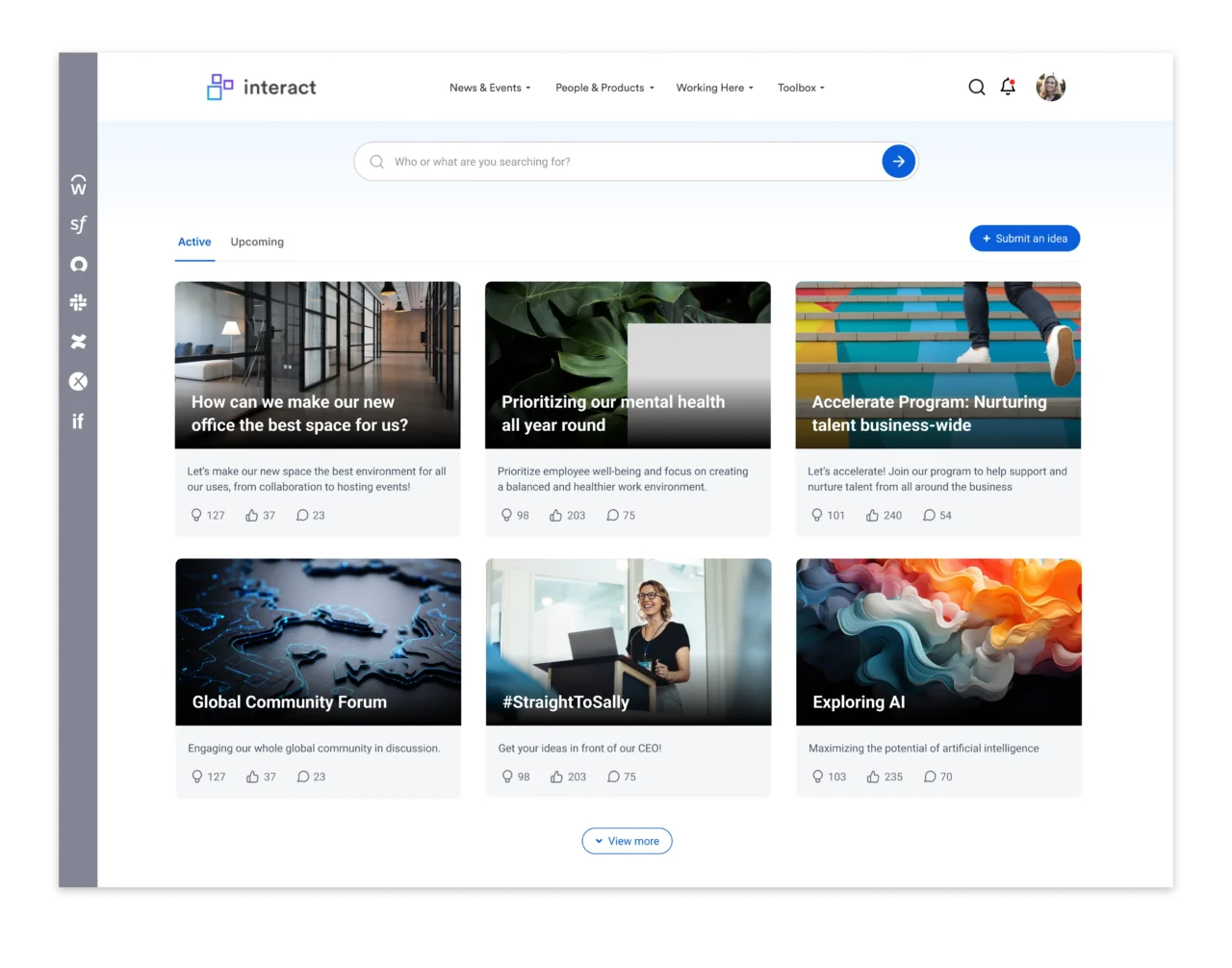
That’s why modern intranet platforms are such a powerful solution: they put dedicated idea management features at the fingertips of employees by seamlessly integrating with the digital workplace they’re already familiar with.
An EXP helps to create a transparent and accountable system throughout the entire idea lifecycle with:
- Effortless idea capture: It provides a central hub for employees to submit their ideas easily. This eliminates confusion and ensures no brilliant concept gets lost in the shuffle.
- Collaborative evaluation: The platform fosters teamwork by allowing colleagues to discuss, refine, and build upon each other’s ideas. This collaborative approach leads to stronger, more well-rounded solutions.
- Transparent decision-making: Intranet managers can publish clear criteria for evaluating submissions and keep everyone informed as implementation progresses. This transparency builds trust and keeps employees engaged in the innovation process.
- Seamless implementation: The platform can facilitate the transition from promising idea to actionable plan. This ensures valuable suggestions don’t get stymied by bureaucratic bottlenecks.
When employees can easily submit ideas in an intuitive intranet environment that provides a clear and standardized process, it not only eliminates confusion and increases participation, it also allows intranet managers to more efficiently manage and track every suggestion, at scale.
The intranet should never be a one-way street. Forums and discussion boards offer a powerful tool for generating meaningful conversations and fostering a sense of community among employees. Features like a moderator dashboard can empower those leading the idea management project to gain a comprehensive understanding of the conversations happening across the organization. They can visualize participation trends, identify who’s contributing and in what formats (posts, replies, questions), and understand communication preferences by analyzing engagement with various features, like timeline posts.
A dedicated idea management platform within the intranet sends a clear message: employee voices matter. This fosters a culture of inclusion, where employees feel empowered to contribute and valued for their unique perspectives.
Features your idea management software needs
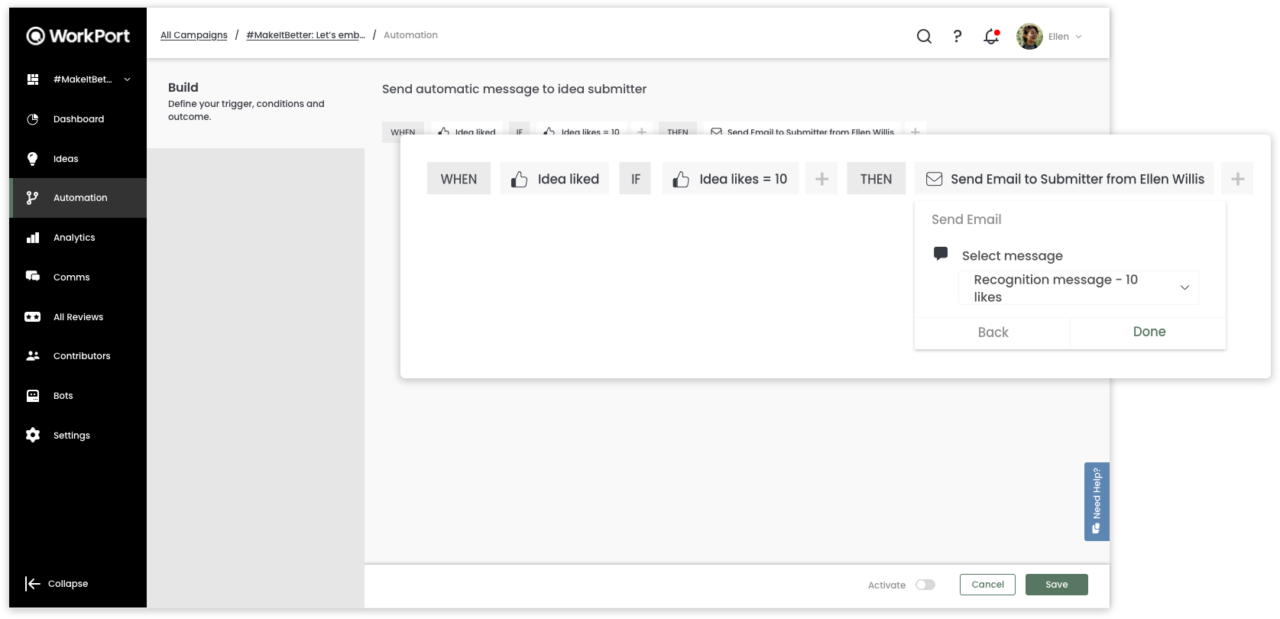
To transform those sparks of inspiration into real impact, choosing an idea management solution with the right features is crucial. The following breakdown outlines the essential functionalities needed to unlock the full potential of an idea management strategy.
- User-friendly interface: Employees are more likely to submit and develop ideas if the idea management software is intuitive and easy to use. Look for a platform with a clean, user-friendly interface that encourages participation and lets you create a dedicated ideas portal within the intranet.
- Seamless workflow integration: Avoid data silos and disruptions in your team’s workflow by ensuring the chosen software integrates seamlessly with the tools your team already uses.
- Customizable ROI reporting: Look for software that allows you to generate custom reports showcasing the return on investment (ROI) associated with each chosen concept so you can measure the true impact of implemented ideas.
- Personalized engagement: Aim for software that automates personalized updates, notifying employees about the progress of their ideas and campaign developments.
- Intelligent pipeline management: Using automation and robust analytics, the platform should facilitate more efficient management and estimate the potential value of ideas within your pipeline, empowering data-driven decision making.
- Robust security protocols: Ensure your chosen software prioritizes data security with features like encryption, access control, and multi-factor authentication.
- Native integrations: Streamline your workflow by choosing software that offers native integrations with your existing collaboration tools and business systems.
- Options for frontline workers: Empower frontline workers to contribute even in areas with limited tech access with features like offline functionality and a mobile-optimized interface.
- Scalability: Accommodate growth by choosing software that allows for easy scaling of user accounts and permissions. Ensure the platform can handle the increasing volume of ideas and data generated as your innovation initiatives expand.
Build vs. buy: Choosing the right idea management option
Should you build your own solution in-house or opt for a pre-built intranet platform with idea management functionality?
This decision requires careful consideration of potential risks, benefits, and the overall impact on operational efficiency and innovation capacity.
Three major factors guide this build versus buy decision:
Cost: While building an in-house solution may appear more cost-effective initially, hidden costs can accumulate quickly:
- Licensing: Fees associated with no-code tools used for development.
- Development resources: Costs for planning, designing, and building the platform.
- Launch and support: Manpower needed for platform deployment and user support.
- Ongoing maintenance: Resources required for adding new features and updates over time.
- Opportunity costs: Time spent by employees on building and managing the platform.
- Hosting costs: Additional charges for data storage.
- Software licenses: Potential costs if your chosen hosting platform requires additional licenses for some employees.
These hidden costs can easily surpass the initial savings illusion. Conversely, specialized solution providers like Interact offer transparent and predictable pricing for idea management integrated within a broader employee experience platform.
The step-by-step plan to creating an employee listening strategy
Time to value: Launching a pre-built solution is typically faster compared to in-house development, allowing organizations to reap benefits sooner. Building in-house might encounter delays due to:
- Internal IT teams have existing priorities and limited resources that may affect development speed.
- Lack of experience with idea management software can lead to unforeseen roadblocks.
Even after launch, in-house solutions may require more time to achieve tangible value in terms of generated ideas, employee engagement, and implemented solutions.
Configurability and scalability: In-house solutions often cater to a single purpose or one specific idea campaign.
- Scaling and running diverse programs with distinct configurations becomes a significant challenge.
- Different campaigns require different workflow automation rules, communication protocols with submitters, data fields for collecting idea information, criteria for expert reviews, and more.
- With an in-house solution, these customizations might not be user-friendly for program overseers, requiring dependence on IT for adjustments.
Reputable idea management capabilities within your existing intranet simplify these processes. They offer pre-built solutions that allow for user-friendly customization and scaling of ideas initiatives, minimizing reliance on IT support.
For many organizations, integrating idea management functionality within an existing intranet platform offers a more streamlined and cost-effective approach. This empowers organizations to leverage a pre-built solution with scalability, expert development, and faster time to value. Ultimately, selecting the right solution paves the way for a successful employee listening strategy, fostering innovation and maximizing the return on investment from your workforce’s ideas.
Idea Management integration with Microsoft Teams
Microsoft Teams has revolutionized collaborative work, fostering communication and knowledge sharing across teams. However, effectively capturing and nurturing a continuous flow of ideas within Teams presents a distinct challenge. This is where dedicated idea management software with Microsoft Teams integration emerges as a strategic solution, empowering employees to contribute to innovation seamlessly within the familiar Teams environment.
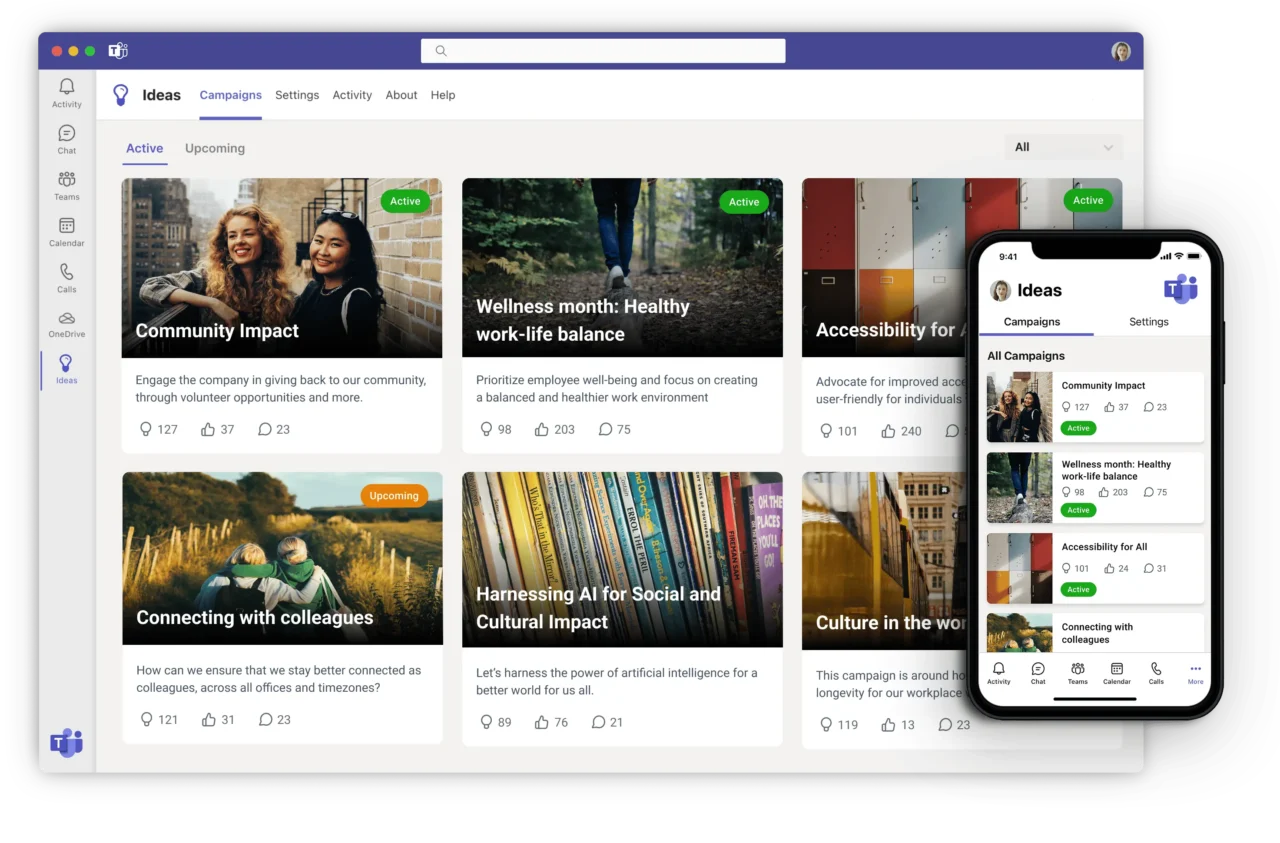
Integrating idea management with Teams offers organizations:
- Enhanced employee engagement: By providing a convenient and familiar platform for idea submission within Teams, employees feel more comfortable and engaged in the ideation process, fostering a culture of innovation.
- Streamlined workflow efficiency: Eliminating the need for employees to switch between different applications makes the entire idea management process more efficient and user-friendly, maximizing employee time and effort.
- Improved visibility and actionable insights: When ideas are readily accessible to all relevant stakeholders within Teams, it promotes greater awareness, encourages prompt action, and ensures valuable opportunities aren’t overlooked.
- Centralized data management and powerful analytics: Comprehensive idea tracking, robust analysis capabilities, and the ability to identify valuable trends that inform strategic decision-making are all made easier by seamlessly integrating a dedicated ideas app within Teams.
By leveraging idea management software integrated with Teams, organizations empower their workforce to contribute to innovation seamlessly. This translates to increased employee engagement, a continuous flow of fresh ideas, and a competitive edge through the strategic application of data-driven insights. Imagine the possibilities when your employees’ brightest ideas are readily captured, collaborated upon, and brought to fruition – all within the familiar environment of Microsoft Teams.
The step-by-step plan to creating an employee listening strategy
Top tips for a successful employee ideas campaign
An employee listening strategy is about more than professional courtesy; it’s a strategic imperative that fuels innovation across all business functions. The consequences of failing to listen are significant. At best, a potentially groundbreaking idea languishes within the organization.
Employee ideas campaigns offer a powerful mechanism for fostering innovation and harnessing the collective ingenuity of your workforce. However, launching a successful campaign requires a strategic approach that goes beyond simply soliciting suggestions.
Here are key considerations to cultivate a program that ignites engagement, generates valuable insights, and ultimately transforms ideas into tangible results.
- Take a targeted approach: Tailor your campaign format to align with your specific goals. Are you seeking immediate cost-saving solutions through a focused, time-bound program? Or, are you embarking on a long-term exploration of novel product concepts? Implementing a strategic mix of campaign types increases your chances of uncovering ideas that have lasting impact.
- Create compelling, consistent content: Spark employee interest through impactful communication efforts. Failing to capture initial attention translates into a lack of participation and consequently, a dearth of valuable ideas. Ensure employees fully grasp the program’s objectives, their role in the process, and the tangible benefits that their contributions yield. By maintaining open communication channels and fostering a culture of employee engagement, you pave the way for a thriving ideas campaign.
- Prioritize simplicity: Complexity is an enemy of participation. When the submission process feels excessively difficult or time-consuming, engagement dwindles. A cumbersome system discourages participation, while a convoluted review process overwhelms managers responsible for idea evaluation. By prioritizing ease of use and streamlined functionality, you encourage ongoing employee participation.
- Leveraging existing platforms: Promote seamless integration. Implement your idea management program within your existing technological ecosystem, such as your intranet or a widely used collaboration software like Microsoft Teams. This minimizes learning curves and fosters widespread adoption.
- Identify clear paths to implementation: The ultimate measure of success lies in transforming promising ideas into reality. Witnessing their ideas come to life not only fuels innovation, but also serves as a significant reward for the contributing employees, further bolstering program engagement.
- Offer acknowledgment and feedback: Acknowledge all submissions and provide thoughtful, constructive feedback regardless of the final decision. This demonstrates respect for employee contributions, fosters understanding of the campaign’s scope, and encourages continued participation and ongoing idea refinement. Aim for timely responses – ideally facilitated by an automated system if available.
- Encourage leadership buy-In: Active leadership involvement is a cornerstone of a successful program. Without strong executive support, employees may perceive the effort as unimportant or a low-priority obligation. To secure leadership buy-in, present a clear and concise business case that highlights the potential short- and long-term benefits of the employee ideas program. Leaders who actively participate inspire broader employee engagement and elevate the program’s significance within the organization.
By embracing these key elements, you can create a dynamic program that unleashes employee creativity, fosters a culture of innovation, and ultimately positions your organization to benefit from a continuous stream of valuable ideas. Not only will you witness a surge in innovation, but your employees will feel valued and invested in the organization’s success – a win-win scenario for all stakeholders.
Real-world examples of idea management success
By harnessing the collective creativity of their workforce, companies like Nestlé, Diageo, and AstraZeneca are achieving remarkable results. These real-world examples demonstrate the power of employee ideas to drive innovation, improve efficiency, and foster a culture of ownership within organizations.
Nestlé
Leading food and beverage company Nestlé implemented an idea management platform that empowered employees at all levels to share insights and collaborate across teams and locations. An incredible 96% of employees submitted ideas, showcasing their engagement and enthusiasm. Over 5,000 employee-generated ideas were received within the first year, illustrating the vast potential for innovation.
For example, the supply chain team identified and implemented process improvements, leading to a 15% waste reduction and increased efficiency. A marketing team member’s idea resulted in a new product line generating $10 million in revenue within its first year. A follow-up survey found that 82% of employees felt their ideas were valued, highlighting a sense of ownership and engagement within the organization.
Diageo
Diageo, the beverage giant known for brands like Smirnoff and Guinness, wanted to tackle internal costs. Their solution? An employee ideas campaign titled “If it was my money.” The campaign encouraged all 35,000 employees to share ideas for improved productivity. It proved successful, leading to some of the best ideas being implemented, such as using production steam as a source of power.
AstraZeneca
Global pharmaceutical giant AstraZeneca utilized an employee idea management program to encourage suggestions for process improvements, new drug development, and strategic initiatives. The platform led to an 80% participation rate, with over 60% of implemented ideas leading to measurable business impact.
One came from a research scientist who proposed using AI to streamline clinical trial recruitment. By implementing this idea, AstraZeneca reduced recruitment timelines by 30%, expediting drug development and improving patient outcomes. Another came from a manufacturing technician, whose idea for optimizing packaging reduced waste materials by 25% and increased production efficiency. Additionally, 85% of employees reported feeling like their ideas are valued.
Beyond idea capture: Cultivating a culture of continuous innovation
The landscape of employee engagement is shifting. It’s no longer just about optimizing business processes and employee satisfaction; it’s about harnessing the power of ideas to navigate an ever-changing world.
According to McKinsey’s State of Organizations report, only 5% of respondents say their organizations already have the capabilities that they need. This highlights a critical need for fresh approaches that idea management platforms can help uncover.
Empowering employees to innovate is crucial, but true success hinges on nurturing their enthusiasm beyond the initial spark.
An effective idea management platform is the fuel that keeps the innovation fire burning. They are the key to fostering a culture of continuous innovation where employees feel valued and encouraged to contribute their brightest ideas, knowing they will be heard and recognized.
Ultimately, the goal is to transform ideas into action. Idea management platforms streamline the entire process, from submission to implementation, while data analytics provide valuable insights for identifying promising ideas and prioritizing resources effectively. By implementing a robust idea management platform, organizations fill the critical innovation capability gap and unlock the full potential of their most valuable asset: their employees.


